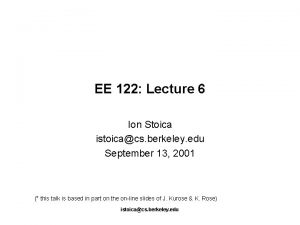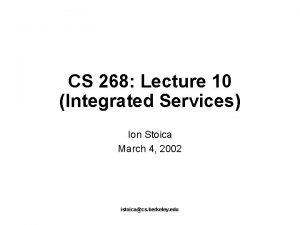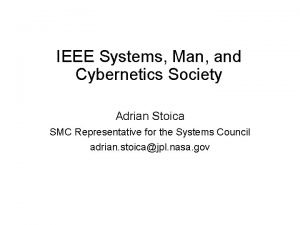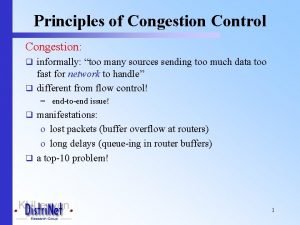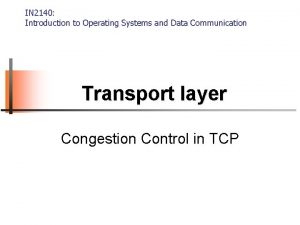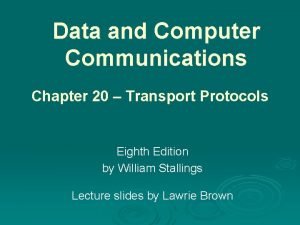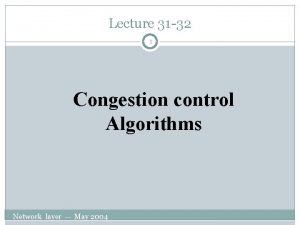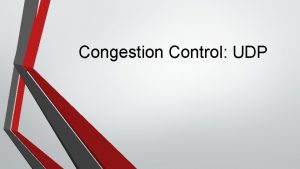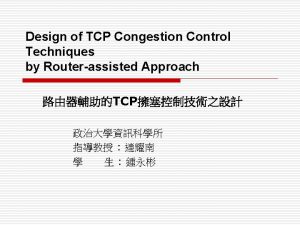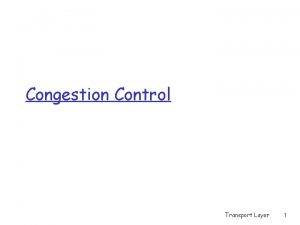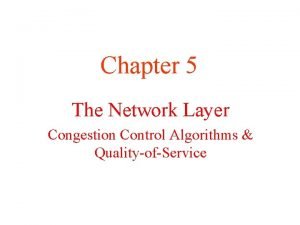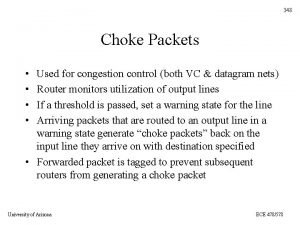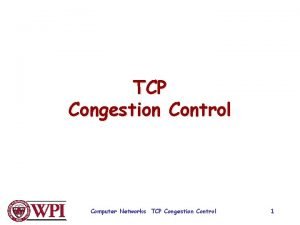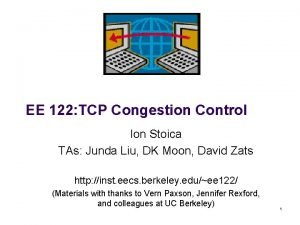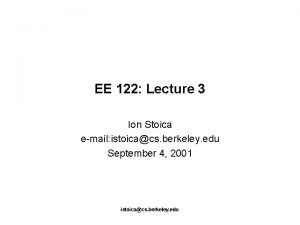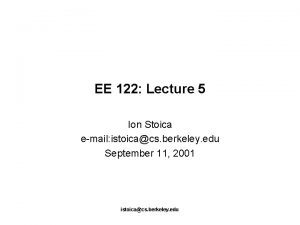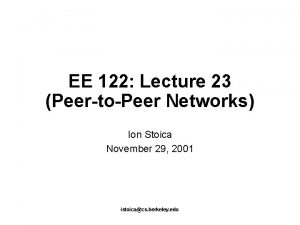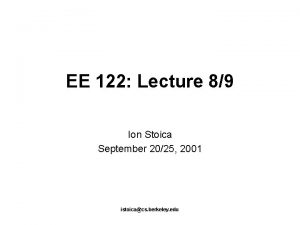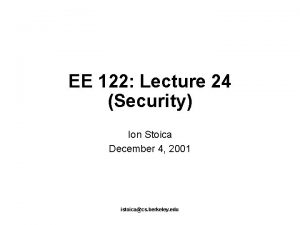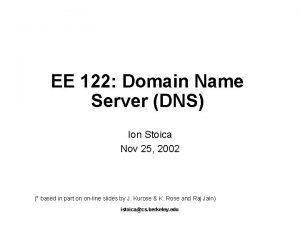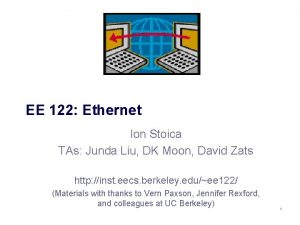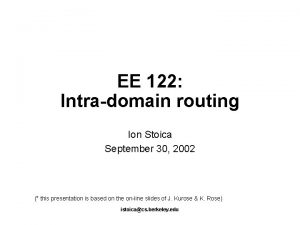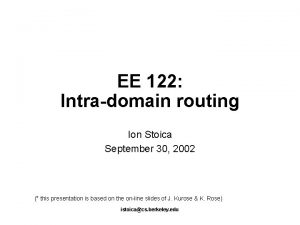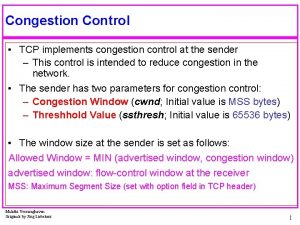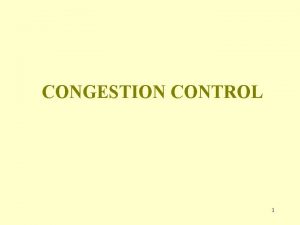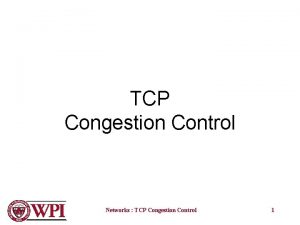EE 122 Lecture 10 Congestion Control Ion Stoica























- Slides: 23

EE 122: Lecture 10 (Congestion Control) Ion Stoica September 26, 2001 istoica@cs. berkeley. edu

Problem § § How much traffic do you send? Two components - flow control • make sure that the receiver can receive as fast as you send Ø congestion control • make sure that the network delivers the packets to the receiver istoica@cs. berkeley. edu 2

Why do You Care About Congestion Control? § § Otherwise you get to congestion collapse How might this happen? - assume network is congested (a router drops packets) - you learn the receiver didn’t get the packet • either by ACK or Timeout - what do you do? retransmit packet - still receiver didn’t get the packet (because it is dropped again) - retransmit again - …. and so on … - and now assume that everyone is doing the same! § Network will become more and more congested - and this with duplicate packets rather than new packets! istoica@cs. berkeley. edu 3

Solutions? § § Increase buffer size. Why not? Slow down - If you know that your packets are not delivered because network congestion, slow down § Questions: - How do you detect network congestion? - By how much do you slow down? istoica@cs. berkeley. edu 4

Knee – point after which - throughput increases very slow - delay increases fast § Cliff – point after which - throughput starts to decrease very fast to zero (congestion collapse) - delay approaches infinity knee Delay § Throughput What’s Really Happening? istoica@cs. berkeley. edu packet loss cliff congestion collapse Load 5

Congestion Control vs. Congestion Avoidance § Congestion control goal - Stay left of cliff Congestion avoidance goal - Stay left of knee Throughput § knee cliff congestion collapse Load istoica@cs. berkeley. edu 6

Administrative Stuff § 1 st midterm, October 9, 9: 30 am - Close book - No notes • You’ll be given any formula, if you need it - No calculator • You’ll have only simple calculation § § 2 nd homework available on-line, due on October 4, 9: 30 am 6 slides/page handouts, with large slides - In general, we cannot put the on-line right away because the department doesn’t have access to Acrobat Distiller istoica@cs. berkeley. edu 7

Goals § § § Operate near the knee point Remain in equilibrium How to maintain equilibrium? - Don’t put a packet into network until another packet leaves. How do you do it? - Use ACK: send a new packet only after you receive and ACK (self-clocking) - This maintains the number of packets in network “constant” istoica@cs. berkeley. edu 8

How Do You Do It? § Detect when network approaches/reaches knee point Stay there § Questions § - How do you get there? - What if you overshoot (i. e. , go over knee point) ? § Possible solution: - Increase window size until you notice congestion - Decrease window size if network congested istoica@cs. berkeley. edu 9

Congestion Window (cwnd) § Limits how much data can be in transit Max. Window = min(cwnd, Advertised. Window) Effective. Window = Max. Window – (Last. Byte. Sent – Last. Byte. Acked) Last. Byte. Acked Last. Byte. Sent sequence number increases istoica@cs. berkeley. edu 10

TCP: Slow Start § § Goal: discover congestion quickly How? - Quickly increase cwnd until network congested get a rough estimate of the optimal of cwnd § How do we know when network is congested? - Packet loss (TCP) • Over the cliff congestion control - Congestion notification (DEC Bit scheme) • Over the knee but before the cliff congestion avoidance § How do we know a packet is lost? 11

TCP: Slow Start § Whenever starting traffic on a new connection, or whenever increasing traffic after congestion was experienced: • Set cwnd =1 • Each time a segment is acknowledged increment cwnd by one (cwnd++). § Does Slow Start increment slowly? Not really. In fact, the increase of cwnd is exponential istoica@cs. berkeley. edu 12

Slow Start Example § The congestion window size grows very rapidly cwnd = 1 segment 1 ACK for segm cwnd = 2 segment 3 ents 2 + ACK for segm cwnd = 4 § TCP slows down the increase of cwnd when cwnd >= ssthresh cwnd = 8 istoica@cs. berkeley. edu 3 segment 4 segment 5 segment 6 segment 7 ents 4+5+6+7 ACK for segm 13

Congestion Avoidance § § Goal: maintain operating point at the left of the cliff: How? - Additive increase: starting from the rough estimate, slowly increase cwnd to probe for additional available bandwidth - Multiplicative decrease: cut congestion window size aggressively if a timeout occurs 14

Congestion Avoidance § § Slow down “Slow Start” If cwnd > ssthresh then each time a segment is acknowledged increment cwnd by 1/cwnd (cwnd += 1/cwnd). So cwnd is increased by one only if all segments have been acknowledged. ssthresh – slow start threshold (more about ssthresh latter) istoica@cs. berkeley. edu 15

Slow Start/Congestion Avoidance Example Cwnd (in segments) § Assume that ssthresh = 8 ssthresh Roundtrip times istoica@cs. berkeley. edu 16

Putting Everything Together: TCP Pseudocode Initially: cwnd = 1; ssthresh = infinite; New ack received: if (cwnd < ssthresh) /* Slow Start*/ cwnd = cwnd + 1; else /* Congestion Avoidance */ cwnd = cwnd + 1/cwnd; Timeout: /* Multiplicative decrease */ ssthresh = win/2; cwnd = 1; 17

The big picture cwnd Timeout Congestion Avoidance Slow Start Time 18

Packet Loss Detection § § Wait for Retransmission Time Out (RTO) What’s the problem with this? Because RTO is performance killer In BSD TCP implementation, RTO is usually more than 1 second - the granularity of RTT estimate is 500 ms - retransmission timeout is at least two times of RTT § Solution: Don’t wait for RTO to expire istoica@cs. berkeley. edu 19

Fast Retransmit § Resend a segment after 3 duplicate ACKs - Remember, a duplicate ACK means that an outof sequence segment was received § segment 1 cwnd = 1 ACK 2 cwnd = 2 segment 3 ACK 3 cwnd = 4 ACK 4 Notes: segment 4 segment 5 segment 6 segment 7 - Duplicate ACKs due 3 duplicate ACKs packet reordering! - If window is small don’t get duplicate ACKs! istoica@cs. berkeley. edu 20

Fast Recovery § After a fast-retransmit set cwnd to ssthresh/2 - i. e. , don’t reset cwnd to 1 § § But when RTO expires still do cwnd = 1 Fast Retransmit and Fast Recovery implemented by TCP Reno; most widely used version of TCP today istoica@cs. berkeley. edu 21

Fast Retransmit and Fast Recovery cwnd Congestion Avoidance Slow Start Fast retransmit § Retransmit after 3 duplicated acks Time - Prevent expensive timeouts § § No need to slow start again At steady state, cwnd oscillates around the optimal window size. 22

Congestion Control Summary § § Architecture: end system detects congestion and slow down Starting point: - Slow start/congestion avoidance • packet drop detected by retransmission timeout RTO as congestion signal - Fast retransmission/fast recovery • packet drop detected by (three) duplicate acks § Router support - Binary feedback scheme: explicit signaling • Today Explicit Congestion Notification [RF 99] - (we’ll see more in Lecture 11) istoica@cs. berkeley. edu 23
 Ion stoica berkeley
Ion stoica berkeley Ion stoica
Ion stoica Circumciliary congestion and conjunctival congestion
Circumciliary congestion and conjunctival congestion Beatrice stoica
Beatrice stoica Monica stoica
Monica stoica Emilia stoica
Emilia stoica Adrian stoica jpl
Adrian stoica jpl Emilia ion procuror
Emilia ion procuror General principles of congestion control
General principles of congestion control Tcp congestion control
Tcp congestion control Tcp congestion control
Tcp congestion control Traffic throttling and load shedding
Traffic throttling and load shedding What are the general principles of congestion control
What are the general principles of congestion control Principles of congestion control in computer networks
Principles of congestion control in computer networks Congestion control in virtual circuit
Congestion control in virtual circuit Udp congestion control
Udp congestion control New reno tcp
New reno tcp Principles of congestion control
Principles of congestion control Congestion control in network layer
Congestion control in network layer Packet choke
Packet choke Tcp congestion control
Tcp congestion control General principles of congestion control
General principles of congestion control C6h12 fuerza intermolecular
C6h12 fuerza intermolecular Fuerzas dipolo dipolo ejemplos
Fuerzas dipolo dipolo ejemplos
